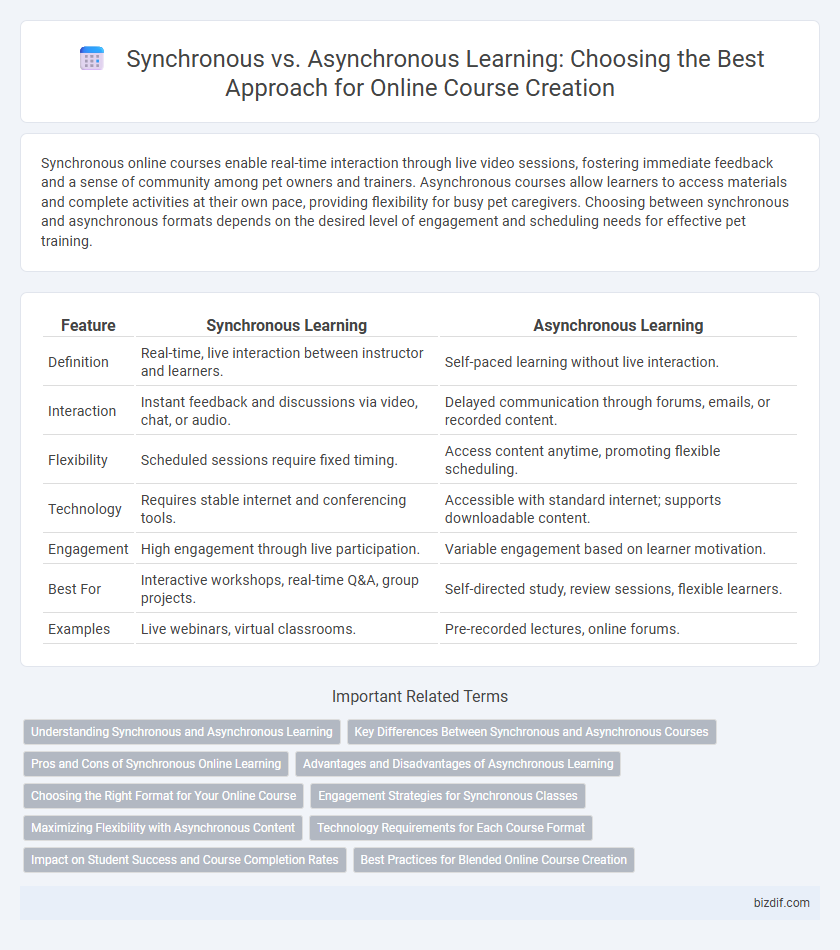Synchronous online courses enable real-time interaction through live video sessions, fostering immediate feedback and a sense of community among pet owners and trainers. Asynchronous courses allow learners to access materials and complete activities at their own pace, providing flexibility for busy pet caregivers. Choosing between synchronous and asynchronous formats depends on the desired level of engagement and scheduling needs for effective pet training.
Table of Comparison
| Feature | Synchronous Learning | Asynchronous Learning |
|---|---|---|
| Definition | Real-time, live interaction between instructor and learners. | Self-paced learning without live interaction. |
| Interaction | Instant feedback and discussions via video, chat, or audio. | Delayed communication through forums, emails, or recorded content. |
| Flexibility | Scheduled sessions require fixed timing. | Access content anytime, promoting flexible scheduling. |
| Technology | Requires stable internet and conferencing tools. | Accessible with standard internet; supports downloadable content. |
| Engagement | High engagement through live participation. | Variable engagement based on learner motivation. |
| Best For | Interactive workshops, real-time Q&A, group projects. | Self-directed study, review sessions, flexible learners. |
| Examples | Live webinars, virtual classrooms. | Pre-recorded lectures, online forums. |
Understanding Synchronous and Asynchronous Learning
Synchronous learning involves real-time interaction between instructors and students through live video sessions, chat, or virtual classrooms, fostering immediate feedback and dynamic discussions. Asynchronous learning allows students to access course materials, lectures, and assignments at their own pace, providing flexibility and accommodating diverse schedules. Understanding the benefits and limitations of both synchronous and asynchronous learning helps course creators design effective and engaging online educational experiences.
Key Differences Between Synchronous and Asynchronous Courses
Synchronous courses require real-time interaction between instructors and students through live video, chat, or phone, facilitating immediate feedback and collaborative learning. Asynchronous courses allow learners to access materials, complete assignments, and communicate at their own pace, providing flexibility and accommodating different schedules. Key differences include timing of participation, communication style, and level of instructor involvement, impacting student engagement and course accessibility.
Pros and Cons of Synchronous Online Learning
Synchronous online learning offers real-time interaction between instructors and students, promoting immediate feedback and active engagement that can enhance understanding and motivation. However, it requires participants to adhere to fixed schedules, which may limit flexibility and accessibility for learners in different time zones or with conflicting commitments. Technical issues such as internet connectivity problems can disrupt the learning experience, making synchronous sessions potentially less reliable than asynchronous options.
Advantages and Disadvantages of Asynchronous Learning
Asynchronous learning offers flexibility, allowing students to access course materials and complete assignments on their own schedules, which can improve time management and accommodate diverse learning paces. It fosters self-discipline and independence but may lead to feelings of isolation and delayed feedback compared to synchronous learning environments. The lack of real-time interaction can challenge immediate clarification of doubts and affect engagement, although it supports scalable education and access for a wider audience.
Choosing the Right Format for Your Online Course
Selecting the appropriate format for your online course depends on learner engagement and flexibility needs. Synchronous courses offer real-time interaction and immediate feedback, enhancing collaboration and motivation. Asynchronous courses provide learners with the freedom to access content at their own pace, supporting diverse schedules and self-directed learning.
Engagement Strategies for Synchronous Classes
Synchronous online classes boost engagement through real-time interaction, enabling live discussions, instant feedback, and collaborative activities that foster a sense of community. Utilizing tools such as breakout rooms, polls, and interactive whiteboards increases student participation and maintains attention. Scheduling consistent class times and incorporating multimedia elements also enhance focus and motivation in synchronous learning environments.
Maximizing Flexibility with Asynchronous Content
Asynchronous online courses maximize flexibility by allowing learners to access content anytime, accommodating different time zones and individual schedules. This format supports self-paced learning, enabling students to review materials multiple times and deepen understanding at their own convenience. By eliminating the need for real-time interaction, asynchronous courses increase accessibility and promote consistent engagement across diverse learner demographics.
Technology Requirements for Each Course Format
Synchronous online courses demand real-time communication tools such as video conferencing platforms, stable high-speed internet, and reliable audio-visual equipment to ensure seamless live interaction. Asynchronous courses require a robust learning management system (LMS) that supports multimedia content, discussion forums, and self-paced assessments, allowing learners to access materials anytime. Both formats benefit from cloud storage solutions and mobile-friendly interfaces to enhance accessibility and user engagement.
Impact on Student Success and Course Completion Rates
Synchronous online courses enhance student success by fostering real-time interaction, immediate feedback, and a structured learning environment, which significantly improves course completion rates. Asynchronous courses offer flexibility and self-paced learning, benefiting students with varied schedules but often resulting in lower completion rates due to reduced engagement and accountability. Combining synchronous and asynchronous elements can optimize student outcomes by balancing flexibility with interactive support.
Best Practices for Blended Online Course Creation
Effective blended online course creation integrates synchronous sessions for real-time interaction and asynchronous modules for flexible, self-paced learning. Best practices emphasize balancing live engagement through video conferencing with accessible recorded lectures and interactive forums to enhance learner autonomy. Incorporating clear schedules, timely feedback, and diverse multimedia resources optimizes student participation and knowledge retention.
Synchronous vs Asynchronous Infographic

 bizdif.com
bizdif.com